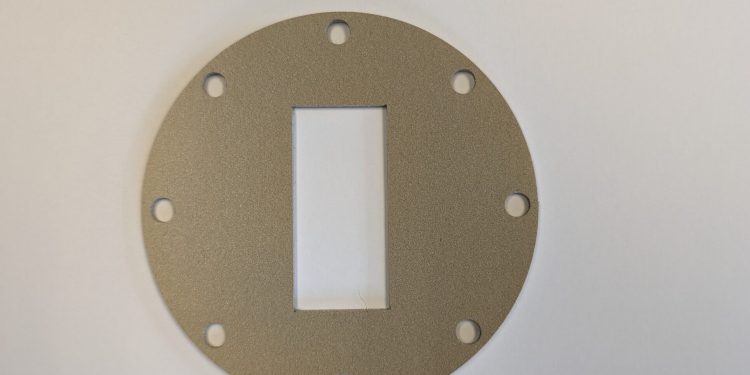Managing electromagnetic interference (EMI) and radio-frequency interference (RFI) is critical for performance and regulatory compliance. To minimize enclosure integrity, engineers need to minimize the leakage of unwanted emissions or the ingress of internal signals. Die cut EMI gaskets from SSP can help.
This article is written for engineers who design or specify EMI shielding gaskets, with a focus on die-cut conductive elastomers, material choices, design considerations, and best practices. Specialty Silicone Products, Inc. (SSP) makes a full line of EMI/RFI shielding silicones, and we have our own toolroom we can machine dies.
What are Die Cut EMI Gaskets?
A die-cut EMI gasket is a part that’s fabricated from a sheet or roll of an electrically conductive elastomeric material. The gasket is cut with a steel-rule or other type of die to a specified geometry that matches the enclosure flange or mating surfaces.
When compressed, the EMI gasket forms an environmental seal against dust, humidity, moisture. It also forms an electrical path so that the cut gasket becomes part of the shielding interface between the enclosure halves or between a chassis and cover.
Die Cut EMI Gasket Materials
When selecting die cut emi gasket materials, consider what SSP offers and how we offer a choice of electrically conductive elastomers.
Key features of SSP’s EMI shielding silicones include:
- Materials are manufactured in a ISO 9001 :2015 certified facility in Ballston Spa, NY.
- Many of our EMI shielding silicones appear on the MIL-DTL-83528 Qualified Product List (QPL) from the U.S. Defense Logistics Agency (DLA).
- Our portfolio also includes cost-effective EMI elastomers that contain nickel-graphite particles instead of silver-plated ones.
Design Considerations for Die Cut EMI Gasketing
When specifying and designing products, consider electrical shielding performance, mechanical sealing performance, environmental durability and manufacturability. Here are some general guidelines.
EMI Shielding Performance
A die cut EMI gasket must provide a reliable electrical contact between the enclosure halves or mating surfaces, closing the electromagnetic path and thus lowering transfer impedance or insertion loss. Importantly, gaskets must be properly deflected to perform, and each type of gasket and cross section has a unique deflection curve.
Because EMI silicone gaskets contain electrically conductive fillers (e.g., nickel, silver-plated aluminum), engineers should verify vendor test data and understand the frequency range. Many of SSP’s EMI shielding silicones have been third-party tested, and we share these test reports right on our website.
Environmental Factors
Simulating an enclosure’s environment can help prevent seal failure. For example, will the EMI seal undergo temperature cycling, vibration, chemical exposure, salt spray, or vacuum conditions? SSP categorizes materials accordingly and offers materials that are corrosion resistant, fuel/solvent resistant, or have low silicone outgassing.
Mechanical Factors
Mechanical factors to consider include compression set, tear/elongation performance, and durability under repeated assembly/disassembly hinge cycles.
Sealability and Geometry
A die cut EMI gasket needs to provide both electrical and environmental sealing. Remember to optimize the geometry because material selection alone doesn’t guarantee sealing performance. Also, consider whether the enclosure uses bolts, latches or hinges, and design the gasket geometry accordingly (e.g., thickness, cross-section, cut features, adhesives).
Manufacturability, Cost and Installation
Die cut EMI gaskets offer advantages in rapid production and lower tooling costs compared to custom molded parts. However, early design for manufacturability (DFM) is needed. The placement of bolt holes, tolerances, adhesive backing, sheet size, scrap waste and die-cut tolerances must all be addressed.
Die Cutting Specific Considerations
Some of the more frequent oversights in product specifications include hole placements too close to the edge, ignoring adhesive ageing or incorrect PSA selection, and tolerances that are inappropriate for die cutting.
Best Practices for Die Cut EMI Gaskets
For engineers specifying die-cut EMI gaskets, follow these best practices:
- Involve the gasket fabricator early in the design cycle. Early supplier engagement helps optimize hole placement, material selection, adhesive backing options, and manufacturability.
- Specify the “real world” assembly conditions: flange clamping force, enclosure gap variation, surface finishes, vibration profile, environmental exposures. This ensures the gasket material is appropriate for the application.
- Check for QPL or equivalent certifications if your application demands military/aerospace performance, SSP’s MIL-DTL-83528 QPL certified silicones support compliance.
- Design for repeatability and serviceability: If the enclosure will be opened and closed multiple times, choose materials with low compression set, consider adhesives that maintain compliance, and design geometry for consistent seating.
- Ensure installation accuracy: Use alignment features, install jigs if needed, specify PSA release liners if appropriate, and watch for installation errors that degrade shielding performance.
- Prototype and test early: Build a prototype die-cut gasket, install into your enclosure, perform EMI testing (shielding effectiveness across relevant frequencies), mechanical tests (compression set, durability) and environmental tests (corrosion, out-gassing).
- Document and maintain supplier data: Review datasheets on materials (conductivity, compression set, environmental ratings), obtain test reports, and maintain change-control procedures. SSP shares test reports on its website.
- Balance cost vs performance: Using SSP’s cost-effective nickel-graphite silicones can reduce costs while providing sufficient performance. Don’t default to using premium silver-coated fills unless they’re required.
Ask SSP for Die Cut EMI Gaskets
Die-cut EMI gaskets made from conductive silicone elastomers are a versatile and effective solution for engineers seeking to provide both environmental sealing and electromagnetic shielding in electronic enclosures. SSP manufactures a wide range of EMI shielding silicones and can fabricate the materials we make into die cut EMI gaskets.
Contact SSP to request a quote or for more information.





